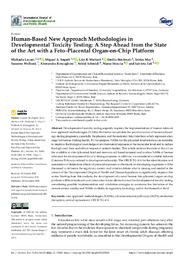Resumen :
Download PDFsettingsOrder Article Reprints
Open AccessReview
Human-Based New Approach Methodologies in Developmental Toxicity Testing: A Step Ahead from the State of the Art with a Feto–Placental Organ-on-Chip Platform
by Michaela Luconi 1,2,†ORCID,Miguel A. Sogorb 3,†ORCID,Udo R. Markert 4ORCID,Emilio Benfenati 5,Tobias May 6,Susanne Wolbank 7ORCID,Alessandra Roncaglioni 5,Astrid Schmidt 4,Marco Straccia 8ORCID andSabrina Tait 9,*ORCID
1
Department of Experimental and Clinical Biomedical Sciences “Mario Serio”, University of Florence, Viale Pieraccini 6, 50139 Florence, Italy
2
I.N.B.B. (Istituto Nazionale Biostrutture e Biosistemi), Viale Medaglie d’Oro 305, 00136 Rome, Italy
3
Instituto de Bioingeniería, Universidad Miguel Hernández de Elche, Avenida de la Universidad s/n, 03202 Elche, Spain
4
Placenta Lab, Department of Obstetrics, University Hospital Jena, Am Klinikum 1, 07747 Jena, Germany
5
Department of Environmental Health Sciences, Istituto di Ricerche Farmacologiche Mario Negri IRCCS, Via Mario Negri 2, 20156 Milan, Italy
6
InSCREENeX GmbH, Inhoffenstr. 7, 38124 Braunschweig, Germany
7
Ludwig Boltzmann Institut for Traumatology, The Research Center in Cooperation with AUVA, Austrian Cluster for Tissue Regeneration, Donaueschingenstrasse 13, 1200 Vienna, Austria
8
FRESCI by Science&Strategy SL, C/Roure Monjo 33, Vacarisses, 08233 Barcelona, Spain
9
Centre for Gender-Specific Medicine, Istituto Superiore di Sanità, 00161 Rome, Italy
*
Author to whom correspondence should be addressed.
†
These authors contributed equally to this work.
Int. J. Environ. Res. Public Health 2022, 19(23), 15828; https://doi.org/10.3390/ijerph192315828
Submission received: 24 October 2022 / Revised: 20 November 2022 / Accepted: 25 November 2022 / Published: 28 November 2022
(This article belongs to the Section Toxicology and Public Health)
Downloadkeyboard_arrow_down Browse Figures Review Reports Versions Notes
Abstract
Developmental toxicity testing urgently requires the implementation of human-relevant new approach methodologies (NAMs) that better recapitulate the peculiar nature of human physiology during pregnancy, especially the placenta and the maternal/fetal interface, which represent a key stage for human lifelong health. Fit-for-purpose NAMs for the placental–fetal interface are desirable to improve the biological knowledge of environmental exposure at the molecular level and to reduce the high cost, time and ethical impact of animal studies. This article reviews the state of the art on the available in vitro (placental, fetal and amniotic cell-based systems) and in silico NAMs of human relevance for developmental toxicity testing purposes; in addition, we considered available Adverse Outcome Pathways related to developmental toxicity. The OECD TG 414 for the identification and assessment of deleterious effects of prenatal exposure to chemicals on developing organisms will be discussed to delineate the regulatory context and to better debate what is missing and needed in the context of the Developmental Origins of Health and Disease hypothesis to significantly improve this sector. Starting from this analysis, the development of a novel human feto–placental organ-on-chip platform will be introduced as an innovative future alternative tool for developmental toxicity testing, considering possible implementation and validation strategies to overcome the limitation of the current animal studies and NAMs available in regulatory toxicology and in the biomedical field.
|
 La licencia se describe como: Atribución-NonComercial-NoDerivada 4.0 Internacional.
La licencia se describe como: Atribución-NonComercial-NoDerivada 4.0 Internacional.
.png)
